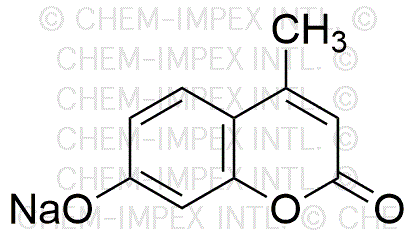4-Methylumbelliferone sodium salt is widely utilized in research focused on:
- Fluorescent Probes: This compound is often used as a fluorescent marker in biological assays, allowing researchers to visualize cellular processes and track biomolecules in real-time.
- Enzyme Activity Studies: It serves as a substrate for various enzymes, particularly in studies involving glucuronidation, helping scientists understand metabolic pathways and enzyme kinetics.
- Antioxidant Research: The compound is investigated for its potential antioxidant properties, making it relevant in studies aimed at combating oxidative stress in cells.
- Drug Development: Its role in inhibiting certain enzymes makes it a candidate for developing new therapeutic agents, particularly in cancer research where enzyme modulation is crucial.
- Cellular Imaging: Researchers use it in imaging techniques to enhance the visibility of cellular structures, aiding in the study of cell morphology and function.
Informations générales
Propriétés
Sécurité et réglementation
Applications
4-Methylumbelliferone sodium salt is widely utilized in research focused on:
- Fluorescent Probes: This compound is often used as a fluorescent marker in biological assays, allowing researchers to visualize cellular processes and track biomolecules in real-time.
- Enzyme Activity Studies: It serves as a substrate for various enzymes, particularly in studies involving glucuronidation, helping scientists understand metabolic pathways and enzyme kinetics.
- Antioxidant Research: The compound is investigated for its potential antioxidant properties, making it relevant in studies aimed at combating oxidative stress in cells.
- Drug Development: Its role in inhibiting certain enzymes makes it a candidate for developing new therapeutic agents, particularly in cancer research where enzyme modulation is crucial.
- Cellular Imaging: Researchers use it in imaging techniques to enhance the visibility of cellular structures, aiding in the study of cell morphology and function.
Documents
Fiches de données de sécurité (FDS)
La FDS fournit des informations de sécurité complètes sur la manipulation, le stockage et l’élimination du produit.
Spécifications du produit (PS)
Le PS fournit une description complète des propriétés du produit, notamment sa composition chimique, son état physique, sa pureté et les exigences de stockage. Il détaille également les plages de qualité acceptables et les applications prévues du produit.
Certificats d'analyse (COA)
Recherchez des certificats d'analyse (COA) en saisissant le numéro de lot du produit. Les numéros de lot et de lot se trouvent sur l'étiquette d'un produit, après les mots « Lot » ou « Lot de fabrication ».
Numéro de catalogue
Numéro de lot/série
Certificats d'origine (COO)
Ce certificat d'exploitation confirme le pays dans lequel le produit a été fabriqué, et détaille également les matériaux et composants utilisés et s'il est issu de sources naturelles, synthétiques ou autres sources spécifiques. Ce certificat peut être requis pour les douanes, le commerce et la conformité réglementaire.
Numéro de catalogue
Numéro de lot/série
Fiches de données de sécurité (FDS)
La FDS fournit des informations de sécurité complètes sur la manipulation, le stockage et l’élimination du produit.
DownloadSpécifications du produit (PS)
Le PS fournit une description complète des propriétés du produit, notamment sa composition chimique, son état physique, sa pureté et les exigences de stockage. Il détaille également les plages de qualité acceptables et les applications prévues du produit.
DownloadCertificats d'analyse (COA)
Recherchez des certificats d'analyse (COA) en saisissant le numéro de lot du produit. Les numéros de lot et de lot se trouvent sur l'étiquette d'un produit, après les mots « Lot » ou « Lot de fabrication ».
Numéro de catalogue
Numéro de lot/série
Certificats d'origine (COO)
Ce certificat d'exploitation confirme le pays dans lequel le produit a été fabriqué, et détaille également les matériaux et composants utilisés et s'il est issu de sources naturelles, synthétiques ou autres sources spécifiques. Ce certificat peut être requis pour les douanes, le commerce et la conformité réglementaire.


